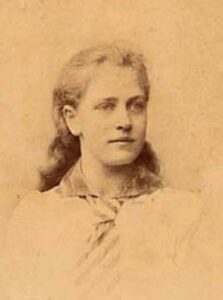
Lucie van Dam van Isselt (1871–1949) was a Dutch painter, draftsman and etcher, who mastered still lifes, flowers as well as portraits.
“During the night I made such a beautiful painting. All I have to do now is paint it.”
Lucie van Dam van Isselt
Photo by C.E. Westerborg, s.d.
Lucie van Dam van Isselt was born on 15th June 1871, in Bergen Op Zoom. She was the daughter of first lieutenant Jacob Thomas Theodoor Carel van Dam van Isselt en Henriette Marie Lucresia Drabbe.
Professional training
1891-1894 Painting lessons at Royal Aacademy of Visual Arts in Den Haag.
1892 – Summer School at the Royal Academy of Visual Arts in Den Haag
1908 – Graphic techniques lessons from Auguste Morisot at the École des Beaux Arts, Lyon.
Life & work
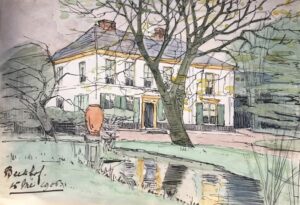 In 1892 she married Evert Ekker (1858-1943), who was also a painter. Unfortunately this was not a happy marriage. Two sons were born, in 1899 Evert Jr. and in 1901 Martin Hendrik. In the meantime (1900) the couple had moved from The Hague to Oosterbeek, to the Villa De Beekhof, which had a studio for both of them. Their Oosterbeek villa grew into a meeting place for artists, including Jan Toorop, who made an excellent portrait of Lucie.
In 1892 she married Evert Ekker (1858-1943), who was also a painter. Unfortunately this was not a happy marriage. Two sons were born, in 1899 Evert Jr. and in 1901 Martin Hendrik. In the meantime (1900) the couple had moved from The Hague to Oosterbeek, to the Villa De Beekhof, which had a studio for both of them. Their Oosterbeek villa grew into a meeting place for artists, including Jan Toorop, who made an excellent portrait of Lucie.
When Lucie could no longer tolerate her family situation, she filed for divorce. In those days this was a disgrace for women, who hardly had any rights. To her great sorrow, Lucie had to leave her children behind when she moved away and settled in Veere in 1907. In this Zeeland town in the South-West of The Netherlands, she lived and worked here until 1933. She was very productive and made hundreds of still lifes, drawings and etchings of everyday subjects like flowers, kitchen utensils and objects from her room as well as landscapes. She counted as one of the Veerse Joffers, a group of women artists like the Amsterdamse Joffers.
She traveled through Europe and painted in various places in Belgium, France and Italy. The work of Flemish (neo)impressionist painter Théo van Rysselberghe was a source of inspiration for her.
In 1909 she married Albert Plasschaert, a Dutch art critic whom she knew from the Oosterbeek gatherings. This marriage did not last either and they divorced in 1922, although they remained friends.
To her great joy, contact with her oldest son Evert was re-established in 1918; he moved in to live with her in 1919. And in 1924 she regained contact with her younger son Martin.
In 1933 she eventually left Veere and moved to Den Haag. The interbellum period was a flourishing time for Veere and it’s artists colony, and why she moved to Den Haag – it is not known. It was the place where she received her professional education and she was a member of Pulchri Studio where she exhibited every year. In Den Haag she started to paint more portraits.
Until the Second World War she made many trips abroad. In her work the whites and grays were subject to nuances, in the twenties they had become lighter, almost translucent, in the thirties the white tended towards yellow and during the war it became a cooler shade.
During WWII Lucie refused to join the ‘Kulturkammer‘ which meant she could nolonger exhibit her work. In February 1945, her house and studio were badly damaged in a bombing raid, Lucie moved to another place within Den Haag. After the war she started exhibiting again, in the summer of 1948 she had her last solo exhibition in Den Haag.
In 1948 she becomes ill and she dies in Den haag on 7th June 1949.
Exhibitions
The works of Lucie van Dam van Isselt were shown in many exhibitions during her life and afterwards. Here we only mention her solo-exhibitions.
1918 Pictura, Dordrecht.
1922 Pictura Den Haag.
1927 Unger & Mens, Rotterdam.
1930 Pictura Den Haag.
1939 Van ABBE Museum, Eindhoven.
1948 Kunstzaal Plaats, Den Haag.
1954 Prinsenhof Delft.
1986 Markiezenhof Bergen op Zoom.
1999 Marie Tak van Poortvliet Museum, Domburg.
2021 Museum Veere, Veere.
Her work can be found in many Dutch museums (e.g. Rijksmuseum, Amsterdam; Stedelijk Museum, Amsterdam; Museum Arnhem, Arnhem; Kunstmuseum, Den Haag; Van Abbemuseum, Eindhoven; Teylers Museum, Haarlem; Kröller-Müller Museum, Otterlo; Museum Boijmans Van Beuningen, Rotterdam; Museum Veere, and many others), as well as in private collections.
Sources
Bakker J. & Ekker K. Lucie van Dam van Isselt, een markante Veerse Joffer. 2021. Museum Veere.
Blok W. Lucie van Dam van Isselt, exhibition catalogue, 1986, Markiezenhof, Bergen op Zoom.
RKD – Dutch Institute for Art History, Den Haag.
Vloten, F. van [red], Een tere stilte en een sterk geluid: Domburgse dames en Veerse joffers. 2009 Deventer.
Wikipedia.org
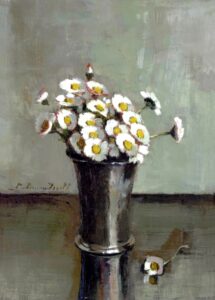
Lucie van Dam van Isselt
Daisies in a Silver Cup
signed on the left, s.d.
oil on panel
40 x 31 cm. (15.75 x 12.2 in.)
Teylers Museum, Haarlem, The Netherlands
© photo Teylers Museum.

Lucie van Dam van Isselt
Flower in blue vase & Chinese plate
Oil on panel
Signed lower right, s.d.
28 x 36 cm.
Previously collection Studio 2000 and Art dealer R. Polak Den Haag.

Lucie van Dam van Isselt
The bird’s nest, 1945
Oil on panel
Signed lower right
29,2 x 39 cm.
Private collection.
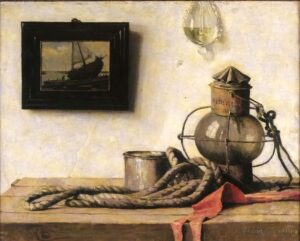
Lucie van Dam van Isselt
The old ship lantern, 1918
Oil on panel
Signed lower right
64,5 x 81,5 cm
Zeeuws Museum, Middelburg.
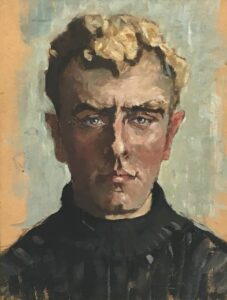
Lucie van Dam van Isselt
Portret van Evert Ekker jr. ca. 1920
Gouach on cardboard
Not signed
45,5 x 35 cm
Private collection.
More of her work can be found on this website:
www.lucievandamvanisselt.nl (in Dutch).